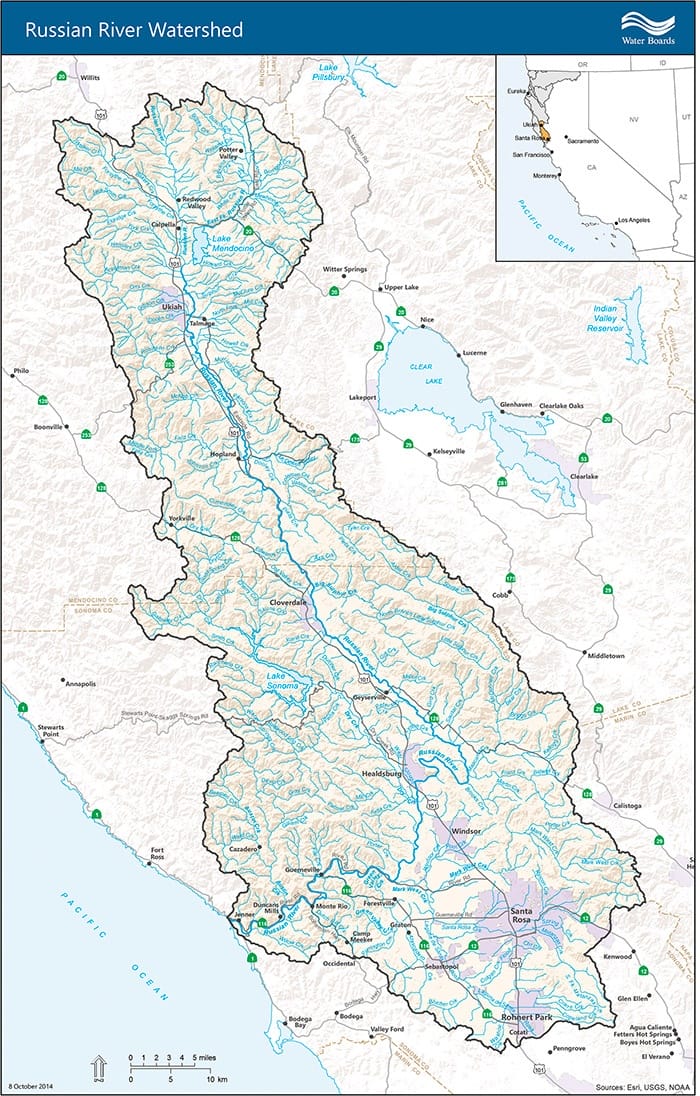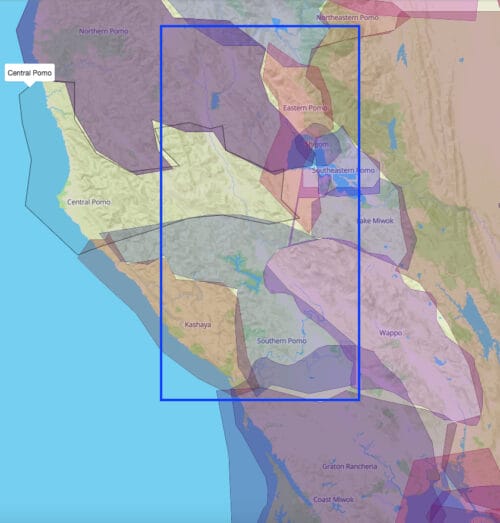About the Russian River


The Russian River watershed resides on the ancestral and unceded lands of the Pomo, Miwok and Wappo Native American tribes who continue to fight for their spiritual and cultural connections to the River and land. You can find out what native lands you reside on at native-land.ca.
The Russian River is 110 miles long with headwaters North of Ukiah, near Willits, that flow southward to Forestville where it runs West and empties into the Pacific at Jenner, entirely on the ancestral and unceded lands of the Pomo, Miwok and Wappo Native American tribes.
The watershed area is roughly 1500 square miles, with large dams Lake Mendocino in Ukiah and Lake Sonoma near Healdsburg. In Potter Valley a PG&E hydroelectric facility diverts water from the Eel River into the East Fork of the Russian River.
The Russian River was first known among the Southern Pomo as Ashokawna, “East water place” or “water to the East.” Pomo, Miwok and Wappo tribes were the first inhabitants of the area living sustainably with the land dating back more than 10,000 years. Later an 1843 Spanish Land Grant referred to it as the Rio Grande before it became the name used today.
The river gets its current name from the Russians of the Russian American Company who settled in Fort Ross just North of Jenner in the early 1800’s and explored the river using native Inuit’s hunting techniques from the far North to trap fur bearing river otters and sea otters off the coast. The Russian American Company left Fort Ross after fur and seal reserves were diminished, and the next wave of settlers arrived. American expansionism through conflict with Spain, Mexico and the exclusion of Native Americans shifted the dominant culture to a majorly Western perspective that came into control of land management practices and policies. Drawn to the plentiful redwoods, logging became the principal industry in the watershed, with mills and railroads sprouting up to cut and transport centuries old redwood to the San Francisco Bay Area to construct buildings and ships in the beginning of the 18th century.
The Russian River has always supported means for living since the first Native Americans because of its bountiful fish populations and abundance of basket making materials. The Russian River is still home to runs of Chinook Salmon, Coho Salmon and Steelhead Trout, although today are endangered and threatened by human encroachment.
Today the Russian River is a cornerstone to the local community and the greater San Francisco Bay area, providing water to over 600,000 residents and summer recreation to almost a million visitors a year. The Russian River’s recreational opportunities to swim, sunbathe, float a tube, canoe or kayak, fish, bird watch, relax, or just get away and connect with nature have drawn visitors and summer residents from the northern California area for over 100 years.
Resources
KRIS supplies technical information about fish, water quality and watershed dynamics.
The North Coast Resource Partnership has many pages of information about the Russian River watershed.
The California Indian Museum and Cultural Center provides the public in Sonoma County with education about California Indian history and cultures as well as present-day legacy preservation.
Russian River Paddle Boards Guide created by Sonoma County Regional Parks, includes river access points.
Swim Guide is a smartphone app that helps you discover beaches along the Russian River and California coast. It shows you the current status of each beach so you know where the water is clean enough to swim every single day. It also allows you to report pollution to your closest Waterkeeper.
